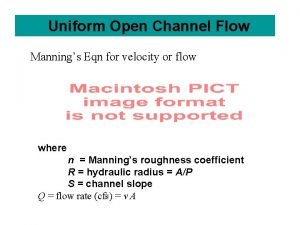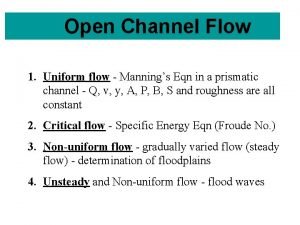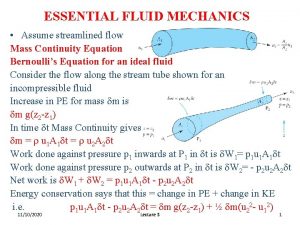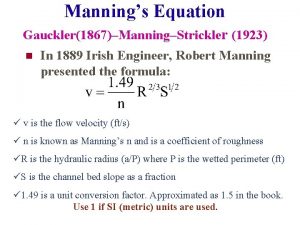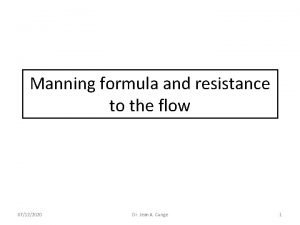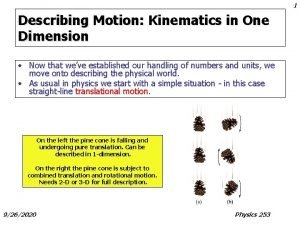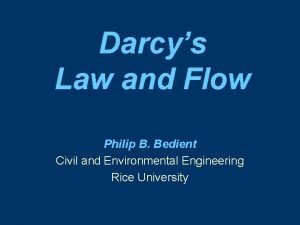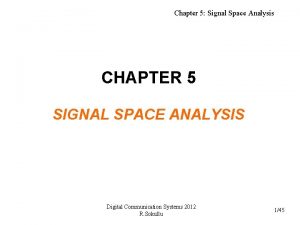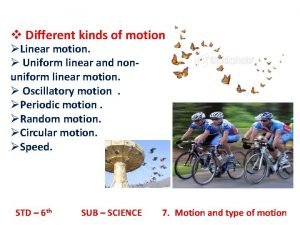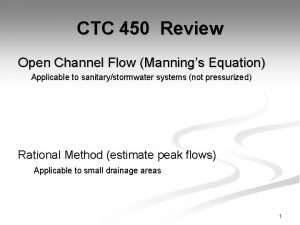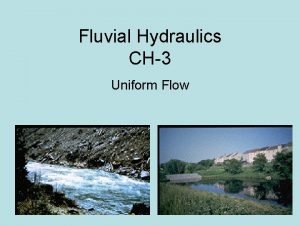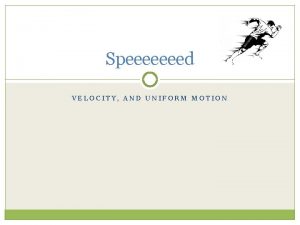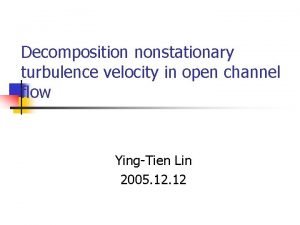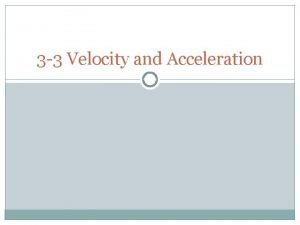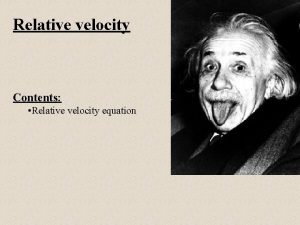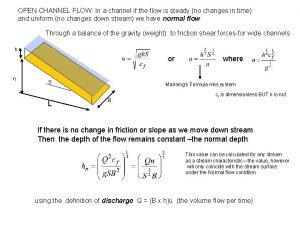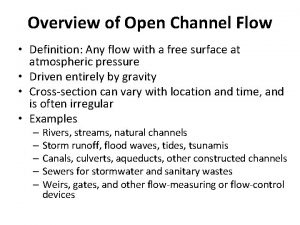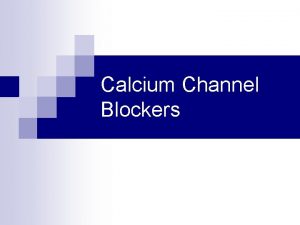Uniform Open Channel Flow Mannings Eqn for velocity
























- Slides: 24

Uniform Open Channel Flow Manning’s Eqn for velocity or flow where n = Manning’s roughness coefficient R = hydraulic radius = A/P S = channel slope Q = flow rate (cfs) = v A

Uniform Open Channel Flow – Brays Bayou Concrete Channel


Normal depth is function of flow rate, and geometry and slope. Can solve for flow rate if depth and geometry are known. Critical depth is used to characterize channel flows -based on addressing specific energy: E = y + Q 2/2 g. A 2 where Q/A = q/y Take d. E/dy = (1 – q 2/gy 3) = 0. For a rectangular channel bottom width b, 1. Emin = 3/2 Yc for critical depth y = yc 2. yc/2 = Vc 2/2 g 3. yc = (Q 2/gb 2)1/3

Critical Flow in Open Channels In general for any channel, B = top width (Q 2/g) = (A 3/B) at y = yc Finally Fr = V/(gy)1/2 = Froude No. Fr = 1 for critical flow Fr < 1 for subcritical flow Fr > 1 for supercritical flow


Optimal Channels

Non-uniform Flow



Non-Uniform Open Channel Flow With natural or man-made channels, the shape, size, and slope may vary along the stream length, x. In addition, velocity and flow rate may also vary with x. Thus, Where H = total energy head z = elevation head, v 2/2 g = velocity head

Replace terms for various values of S and So. Let v = q/y = flow/unit width - solve for dy/dx

Given the Fr number, we can solve for the slope of the water surface - dy/dx Note that the eqn blows up when Fr = 1 or So = S where S = total energy slope So = bed slope, dy/dx = water surface slope

Now apply Energy Eqn. for a reach of length L This Eqn is the basis for the Standard Step Method to compute water surface profiles in open channels

Backwater Profiles - Compute Numerically

Routine Backwater Calculations 1. Select Y 1 (starting depth) 2. Calculate A 1 (cross sectional area) 3. Calculate P 1 (wetted perimeter) 4. Calculate R 1 = A 1/P 1 5. Calculate V 1 = Q 1/A 1 6. Select Y 2 (ending depth) 7. Calculate A 2 8. Calculate P 2 9. Calculate R 2 = A 2/P 2 10. Calculate V 2 = Q 2/A 2

Backwater Calculations (cont’d) 1. Prepare a table of values 2. Calculate Vm = (V 1 + V 2) / 2 3. Calculate Rm = (R 1 + R 2) / 2 4. Calculate Manning’s 5. Calculate L = ∆X from first equation 6. X = ∑∆Xi for each stream reach (SEE SPREADSHEET)

Watershed Hydraulics Bridge D Floodplain Tributary C QD QC Main Stream Bridge Section B QB A Cross Sections QA Cross Sections

Brays Bayou-Typical Urban System • Bridges cause unique problems in hydraulics Piers, low chords, and top of road is considered Expansion/contraction cause hydraulic losses Several cross sections are needed for a bridge Critical in urban settings 288 Crossing

The Floodplain Top Width

Floodplain Determination

The Woodlands v The Woodlands planners wanted to design the community to withstand a 100 -year storm. v In doing this, they would attempt to minimize any changes to the existing, undeveloped floodplain as development proceeded through time.

HEC RAS Cross Section

3 -D Floodplain
 Flow profile in open channel
Flow profile in open channel Uniform open channel flow
Uniform open channel flow Continuity equation definition
Continuity equation definition Manning's equation
Manning's equation Mannings equation
Mannings equation Manning formula
Manning formula Uniform flow
Uniform flow Specific energy in fluid mechanics
Specific energy in fluid mechanics Open channel flow
Open channel flow Open innovation open science open to the world
Open innovation open science open to the world Hydraulic conductivity of soil formula
Hydraulic conductivity of soil formula Linear quantities
Linear quantities Initial velocity and final velocity formula
Initial velocity and final velocity formula Is v final velocity
Is v final velocity What does constant acceleration mean
What does constant acceleration mean Instantaneous velocity vs average velocity
Instantaneous velocity vs average velocity Darcy s law
Darcy s law Tangential speed
Tangential speed Angular acceleration formula in terms of radius
Angular acceleration formula in terms of radius Single channel marketing
Single channel marketing Signal space analysis in digital communication
Signal space analysis in digital communication Determine id
Determine id How do you classify uniform and non-uniform mixtures?
How do you classify uniform and non-uniform mixtures? How do you classify uniform and non-uniform mixtures?
How do you classify uniform and non-uniform mixtures? Which type of motion
Which type of motion
